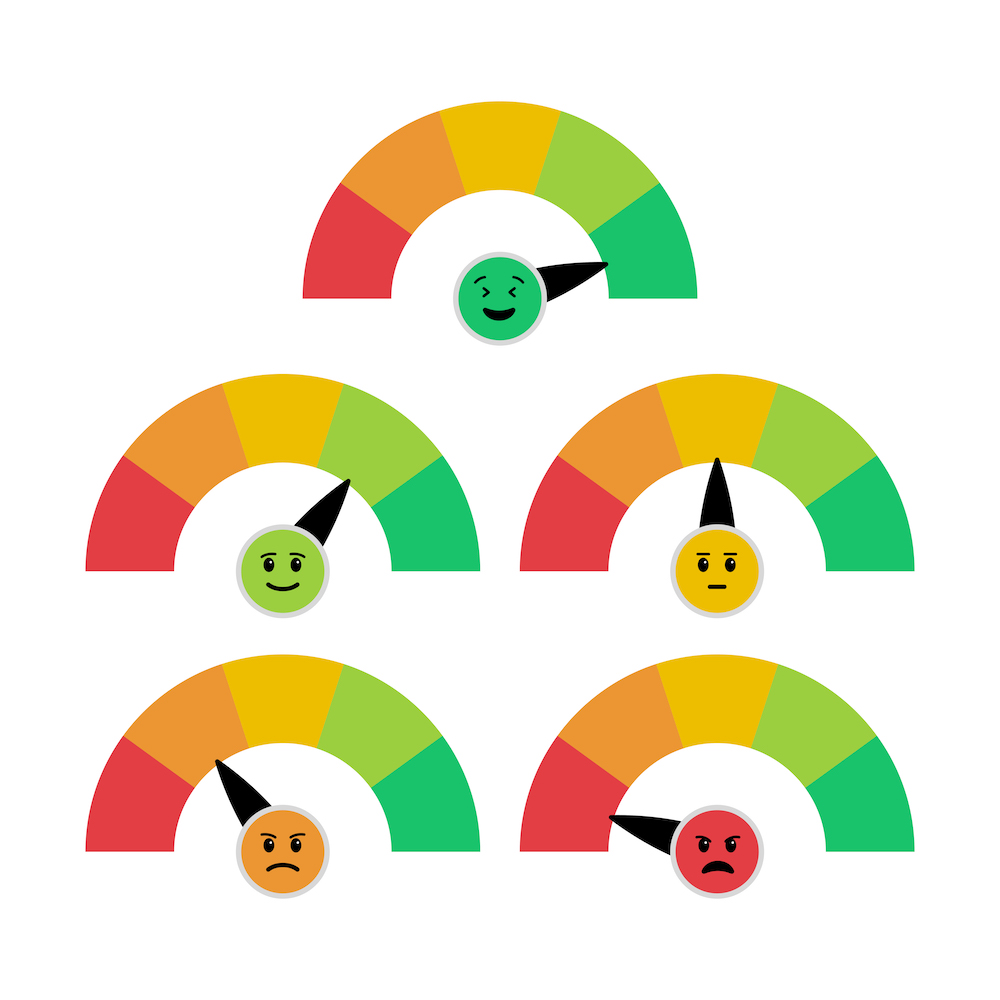This article will guide you through the basics of CSAT, NPS, and CES, illustrating how each measures customer satisfaction differently and the context in which they are most effectively used
In a world where customer satisfaction can make or break a business, understanding the nuances between CSAT vs. NPS vs. CES becomes crucial. These methodologies, each with its unique approach to measuring aspects of customer experience, play pivotal roles in shaping strategies for customer satisfaction and loyalty. Deciphering between a CSAT score, NPS score, and CES score can help you tailor your customer service and product offerings more effectively, ultimately impacting your bottom line. The key to sustained business growth in today's competitive landscape lies not only in attracting new customers but in retaining existing ones by continuously measuring and improving their experience.
This article will guide you through the basics of CSAT, NPS, and CES, illustrating how each measures customer satisfaction differently and the context in which they are most effectively used. You will explore the advantages and disadvantages of CSAT, NPS, and CES, understanding the impact of CSAT score, NPS score, and CES score on your business. Additionally, you will learn strategies for integrating these metrics into your business practices and how to interpret the scores they generate. By providing a comprehensive comparison of CSAT vs. NPS vs. CES, this article equips you with the knowledge to select the most suitable survey tool for your business needs, ensuring you harness the full potential of customer feedback in driving your business forward.
The Basics of CSAT, NPS, and CES
Defining CSAT
Customer Satisfaction Score (CSAT) is a vital metric used to gauge how satisfied customers are with your products or services. It is expressed as a percentage, where 100% indicates complete satisfaction and 0% indicates complete dissatisfaction. Typically, CSAT is measured through customer feedback collected via surveys that ask questions such as, "How would you rate your overall satisfaction with the [goods/service] you received?" Customers respond using a scale from 1 (very unsatisfied) to 5 (very satisfied), and the results can be averaged to provide a composite customer satisfaction score. CSAT is particularly useful for measuring immediate customer reactions to specific interactions, products, or events, although it has limitations in assessing long-term customer relationships.
Defining NPS
Net Promoter Score (NPS) is a widely recognized metric used to measure customer loyalty and predict business growth. It is calculated based on responses to a single question: "On a scale from 0 to 10, how likely are you to recommend our company/product/service to a friend or colleague?" Based on their ratings, respondents are categorized as Promoters (9-10), Passives (7-8), or Detractors (0-6). The final NPS is derived by subtracting the percentage of Detractors from the percentage of Promoters. This score can range from -100 to 100, with higher scores indicating greater customer loyalty. NPS is valuable for assessing overall customer sentiment and loyalty over the longer term.
Defining CES
Customer Effort Score (CES) measures the ease of customer interaction with a company's services and products. It focuses on the effort required by customers to achieve their goals, such as getting help from support teams, making a purchase, or leaving a review. CES is typically assessed through a single survey question that asks customers to rate on a scale, for example, "How easy was it for you to solve your problem today?" with responses ranging from very difficult to very easy. This score helps businesses identify points of friction in the customer journey and is particularly useful for evaluating transactional customer interactions.
How CSAT, NPS, and CES Measure Customer Satisfaction Differently
Focus of CSAT
Customer Satisfaction Score (CSAT) is primarily utilized to gauge satisfaction at specific moments within the customer journey. This metric excels in capturing immediate customer reactions to a particular service, product, or interaction. The calculation of CSAT involves identifying the percentage of customers who provided the highest ratings—on a scale of 1 to 5, this would typically be scores of 4 and 5, representing 'satisfied' and 'very satisfied' customers. Due to its nature, CSAT is highly effective for short-term evaluations but may not fully reflect long-term customer relationships or loyalty.
Focus of NPS
Net Promoter Score (NPS), in contrast, serves a broader purpose by measuring customer loyalty and the likelihood of customers recommending a company to others. This metric categorizes respondents into Promoters, Passives, and Detractors based on their response to how likely they are to recommend the company on a scale from 0 to 10. NPS is particularly valuable for understanding overall customer sentiment and loyalty over a more extended period. It's not just about satisfaction; it's about gauging the customer's intention and their potential to advocate for the brand.
Focus of CES
Customer Effort Score (CES) is centered around the ease of customer interactions with a company’s services or products. Unlike CSAT, which focuses on satisfaction at a particular moment, or NPS, which assesses loyalty and advocacy, CES measures the effort customers must exert to get their issues resolved or needs met. This metric is typically evaluated through a single survey question that asks customers to rate the ease of solving their problem, with responses ranging from very difficult to very easy. CES is crucial for identifying friction points within the customer journey and is a strong predictor of repurchase behavior, as lower effort interactions significantly enhance customer loyalty.
Advantages and Disadvantages of CSAT
Pros
- Simplicity and Intuitiveness: CSAT surveys are known for their straightforward nature. They typically involve just one question with a rating scale, making them easy for your customers to understand and complete. This simplicity ensures that you can deploy these surveys at various customer interaction points without causing disruption.
- Customizable Rating Scales: You have the flexibility to tailor the rating scales according to the context of the survey, which can range from stars and emojis to numeric scales. This customization allows you to align the survey with the preferences of your target audience, potentially increasing its relevance and appeal.
- High Response Rates: Due to their brevity, CSAT surveys often achieve higher response rates compared to other types of customer satisfaction surveys. With fewer questions, customers are more likely to complete the survey, providing you with valuable feedback across different stages of the customer journey.
- Immediate Feedback: CSAT is effective for gauging immediate customer reactions to a service or product. This can be particularly useful for quick assessments post-interaction, allowing you to swiftly identify and address issues.
- Benchmarking Opportunities: Widely adopted across various industries, CSAT scores allow you to benchmark your performance against industry standards, offering a metric for comparative analysis and improvement.
Cons
- Potential for Bias: CSAT scores can be influenced by cultural biases. For example, customers from individualistic cultures might use extreme ratings more frequently than those from collectivistic backgrounds. This can skew your data, making it less representative of the overall customer sentiment.
- Short-term Perspective: CSAT generally reflects short-term sentiment based on the most recent interaction with your business. It may not accurately measure long-term customer satisfaction or loyalty, which are crucial for sustained business growth.
- Ambiguity in Scoring: The interpretation of what constitutes a 'good' or 'bad' CSat score can vary significantly across different industries and companies. This ambiguity can make it challenging to set clear targets or derive actionable insights from the data.
- Limited Depth of Feedback: The simplicity of CSAT surveys, while beneficial for response rates, often means they lack the depth needed to fully understand the nuances of customer satisfaction. This can result in a superficial understanding of customer sentiments, potentially overlooking deeper, underlying issues.
- Response Bias: Not all customers choose to fill out CSAT surveys, often leading to a response bias where only certain types of customers—typically those with very positive or very negative experiences—provide feedback. This can result in data that does not accurately reflect the overall customer experience.
By understanding these advantages and disadvantages, you can better determine how and when to effectively implement CSAT surveys in your business to enhance customer satisfaction and drive improvement.
Advantages and Disadvantages of NPS
Pros
- Proven to Predict Customer Loyalty and Business Growth: The Net Promoter Score (NPS) is widely recognized for its ability to predict customer loyalty and potential business growth. It has shown consistent results across various industries and global markets, making it a reliable metric for gauging customer loyalty.
- Simplicity and Ease of Use: NPS surveys are straightforward to implement, often consisting of just one or two questions. This simplicity makes it easy for your customers to respond and for your team to analyze and convert the data into actionable insights using common tools like Excel or dedicated software.
- Global Benchmarking: With its standardized question format, NPS allows you to compare your company’s performance against others in the same industry. This can be particularly useful for understanding where you stand in terms of customer loyalty and satisfaction.
- Employee Engagement: NPS can also be adapted to measure employee satisfaction and engagement, providing insights into the overall organizational climate and how it might be impacting customer experiences.
- Immediate Feedback for Quick Action: The straightforward nature of the NPS allows for quick feedback collection. This can lead to swift actions based on customer responses, helping you to address issues or capitalize on positive sentiment promptly.
Cons
- Potential for Misinterpretation: While NPS is a popular metric, it can sometimes be misunderstood as a direct measure of customers' likelihood to recommend a service or product. In reality, NPS measures the willingness to recommend as a proxy for overall loyalty, not actual recommendation behaviors.
- Vulnerability to Gaming: Setting strict targets for NPS scores can lead to practices like score begging, where employees might focus more on influencing scores than on genuinely improving customer service and experience.
- Lacks Depth Without Additional Questions: Relying solely on the NPS question can limit the depth of insights you gain. Without asking further questions about the reasons behind a customer’s score, it can be challenging to identify specific areas for improvement.
- Cultural Bias: NPS can vary significantly across different cultural contexts, which can skew results especially for global businesses. Understanding and interpreting these variations is crucial for accurate analysis.
- Focus on Promoters Over Others: NPS primarily highlights the experiences of promoters, potentially overlooking the passive and detractor groups. This can lead to a skewed understanding of overall customer satisfaction and loyalty.
By weighing these advantages and disadvantages, you can more effectively integrate NPS into your broader customer experience strategy, ensuring it complements other metrics and fits your unique business context.
Advantages and Disadvantages of CES
Pros
- Predictive Power of Customer Behavior: CES is highly effective at predicting future customer behavior, including loyalty and repurchase likelihood. Studies, such as one by Harvard Business Review, indicate that customers experiencing low effort are significantly more likely to repurchase and increase their spending.
- Specific and Actionable Insights: This metric offers granular views on distinct aspects of your business that customers interact with, such as support ticket filing or website navigation. If customers report high effort in certain areas, you can pinpoint and address these specific issues.
- Ease of Implementation: CES surveys are straightforward to deploy across various customer interaction points, making it relatively easy to integrate into your existing processes.
- Strong Indicator of Referral Likelihood: High effort levels reported by customers correlate with negative word-of-mouth, making CES a good predictor of referral likelihood.
- Comprehensive Coverage of Client-Facing Processes: CES can be applied to all client-facing processes, providing a holistic view of the customer interaction experience and allowing for targeted improvements.
Cons
- Limited Scope: CES does not measure overall customer satisfaction or the broader relationship customers have with your business. It focuses solely on the effort involved in specific interactions.
- Lack of Detailed Feedback: While CES indicates where customers experience difficulty, it does not provide insights into why these difficulties occur or what exactly was challenging, often requiring additional follow-up queries for deeper understanding.
- Immediate Survey Requirement: For accurate results, CES surveys should be conducted immediately after the customer interaction. Delayed surveys might lead to less accurate feedback as customers' recollections fade.
- Exclusion of External Factors: CES does not account for external influences such as competitor actions, market conditions, or other contextual factors that might affect the customer experience.
- No Segmentation: This metric lacks the capability to segment responses based on different types of customers or their positions in the buyer journey, which can be a significant drawback in tailoring customer experience strategies.
By analyzing these pros and cons, you can decide how to effectively utilize the Customer Effort Score within your broader customer satisfaction and loyalty strategies.
Interpreting Scores for CSAT, NPS, and CES
Understanding CSAT Scores
When you evaluate CSAT scores, it's crucial to consider them in context. A CSAT score is calculated by taking the sum of all positive responses (typically those who rated their satisfaction as either 'satisfied' or 'very satisfied'), dividing by the total number of responses, and then multiplying by 100 to get a percentage. This score gives you a direct measure of customer satisfaction at a specific point in time. For instance, if 80 out of 100 respondents give a positive rating, your CSAT score would be 80%.
Industry benchmarks vary, but a good CSAT score generally falls between 75% and 85%. Scores outside this range can indicate areas needing improvement or, conversely, areas where your company excels. It's also beneficial to look at scores pessimistically; even a high score like 90% suggests room for improvement, as it means 1 in 10 customers were not fully satisfied.
Understanding NPS Scores
The Net Promoter Score (NPS) provides insights into customer loyalty and predicts business growth by categorizing customers into Promoters, Passives, and Detractors based on their likelihood of recommending your business. To calculate NPS, subtract the percentage of Detractors from the percentage of Promoters. For example, if 10% are Detractors and 70% are Promoters, the NPS would be 60.
NPS is recognized as a robust indicator of customer sentiment and loyalty. Scores above 0 are generally good, but an NPS over 50 is excellent, and above 80 is exceptional, indicating very high customer loyalty. However, scores should be interpreted relative to industry norms and competitor scores. For example, an NPS of 30 might be impressive in industries with lower average scores, such as utilities or telecommunications.
Understanding CES Scores
The Customer Effort Score (CES) measures how much effort customers have to exert to get their issues resolved, make a purchase, or use your services. It is typically calculated by asking customers to rate their effort on a scale, where a lower score indicates less effort. A good CES score is one that is low, as this reflects easier customer experiences which are directly linked to higher loyalty and repurchase rates.
Interpreting CES involves looking at the average scores and considering the distribution of responses. If many customers report high effort, it's a signal to investigate and remove friction points in the customer journey. CES is particularly useful for identifying specific operational or service areas that need improvement to enhance the overall customer experience.
By understanding and analyzing CSAT, NPS, and CES scores effectively, you can gain valuable insights into different aspects of customer satisfaction and loyalty, helping you make informed decisions to enhance your business strategies.
When to Use CSAT, NPS, and CES in Your Business
Using CSAT
Customer Satisfaction Score (CSAT) is ideal for measuring immediate customer reactions after specific interactions or experiences with your product or service. Use CSAT when you need quick feedback following sales interactions, customer service encounters, or after customer onboarding processes. This metric is particularly useful for gauging satisfaction on a transactional level, allowing you to rapidly identify and address areas needing improvement. For instance, after a customer completes a purchase or uses a service, a simple CSAT survey can help you determine their level of satisfaction and gather insights to enhance future interactions.
Using NPS
Net Promoter Score (NPS) is best utilized to measure customer loyalty and the overall relationship customers have with your brand over a longer period. This metric is valuable for assessing how likely your customers are to recommend your products or services to others, which is a strong indicator of your company's potential for organic growth and long-term success. NPS is particularly effective when used regularly to track changes in customer sentiment, helping you to understand the broader impacts of business decisions on customer loyalty. Companies often deploy NPS surveys after significant interactions or periodically to gauge ongoing customer perceptions and loyalty levels.
Using CES
Customer Effort Score (CES) is crucial for understanding the amount of effort customers need to exert to get their issues resolved or to interact with your services and products. It is particularly effective immediately after customer service interactions or when a customer uses a new feature or product. CES helps in pinpointing areas where customers are experiencing difficulties, allowing you to streamline processes and reduce friction. This metric is highly predictive of customer loyalty, as a lower effort score is often directly correlated with higher satisfaction and repurchase rates. Use CES to assess specific touchpoints in the customer journey, especially those that involve problem resolution or require customer effort.
Strategies for Integrating CSAT, NPS, and CES Metrics
Integrating Multiple Metrics
When you're considering customer experience metrics like CSAT, NPS, and CES, it's evident that they provide valuable insights when used together rather than in isolation. Each of these metrics numerically explains different facets of customer satisfaction and loyalty, which can significantly enhance your understanding of customer experiences. By integrating CSAT, NPS, and CES, you can obtain a comprehensive overview of your company's strengths and weaknesses, and set specific goals to improve customer satisfaction.
- Complementary Use: CSAT, NPS, and CES can be highly complementary. While CSAT focuses on immediate customer satisfaction, NPS provides broader data on customer loyalty and the likelihood of customers recommending your brand. CES, on the other hand, measures the ease of customer interactions, identifying friction points that could deter customer satisfaction. Together, these metrics provide a layered understanding of your customer experience from individual transactions to overall brand loyalty.
- Layered Insights: Using these metrics in layers can provide deep insights into different aspects of the customer journey. NPS offers a macro view of customer sentiments towards your company, highlighting broader issues or strengths. CSAT can then drill down to how customers feel about specific interactions or services, while CES assesses the ease of these interactions. This layered approach helps in pinpointing precise areas for improvement.
- Simplicity and Clarity: While integrating multiple metrics, it's crucial to maintain simplicity and clarity in your objectives. Ensure that the purpose of using each metric is well understood across your organization to prevent data overload and confusion. This clarity helps in effectively actioning the insights gathered from the metrics.
Choosing the Right Metric for Your Needs
Selecting the right metric or combination of metrics depends on your specific business needs and the aspects of customer experience you wish to measure and improve.
- Single Metric Focus: Sometimes, focusing on a single metric might suffice. For instance, NPS alone can be extended beyond its traditional use to measure specific interactions through transactional surveys, thus providing insights that are usually derived from CSAT.
- Combining Metrics for Broader Insights: In many cases, combining NPS with CES can be particularly effective. While NPS measures customer loyalty and the potential for growth through referrals, CES can provide direct insights into how user-friendly and efficient your services or products are. This combination allows you to measure and enhance both loyalty and operational efficiency concurrently.
- Frequency of Measurement: Determining how often to measure these metrics is also vital. CSAT and CES are typically measured after specific customer interactions to get immediate feedback, while NPS is measured less frequently to assess broader customer loyalty trends. This strategic timing prevents survey fatigue and ensures you receive relevant, actionable feedback without overwhelming your customers.
By understanding how to integrate and choose the right metrics, you can tailor your approach to effectively measure and enhance different aspects of the customer experience. This strategic application not only boosts customer satisfaction but also drives sustained business growth.
Conclusion
Through the exploration of CSAT, NPS, and CES, it becomes evident that these metrics serve as potent tools for deciphering and enhancing various dimensions of customer satisfaction and loyalty. Whether assessing immediate reactions to services with CSAT, gauging long-term loyalty with NPS, or measuring the ease of interaction through CES, integrating these approaches offers a multifaceted understanding of customer experience. This comprehensive view is instrumental for businesses aiming to refine their strategies, ensuring a customer-first approach that fosters sustained engagement and growth.
Adopting the right metric or a combination thereof depends on the specific needs of your business and the aspects of customer experience you aim to improve. By effectively analyzing and acting upon the insights these measures provide, businesses can navigate the complexities of customer satisfaction, tailor their services to meet and exceed customer expectations, and ultimately, cement their position in a competitive marketplace. Embracing CSAT, NPS, and CES in a harmonized strategy empowers businesses to unlock the full potential of customer feedback, driving the continuous evolution of products and services in alignment with customer needs and preferences.
FAQs
1. When should I use CSAT versus NPS for customer feedback?
Use CSAT (Customer Satisfaction Score) to gather immediate feedback on specific interactions, such as after a purchase or a customer service call, to quickly pinpoint areas for improvement. On the other hand, NPS (Net Promoter Score) is better suited for evaluating overall customer sentiment and loyalty over longer periods.
2. What makes CES a better choice compared to NPS?
Customer Effort Score (CES) is unique in that it measures the effort required by customers to resolve issues or complete specific tasks, unlike CSAT and NPS, which focus on measuring customer satisfaction and loyalty, respectively.
3. Should I choose NPS over a customer satisfaction survey to gauge customer understanding?
NPS is a long-term metric designed to assess the likelihood of a customer recommending your product or service to others, indicating broader customer sentiment. In contrast, a customer satisfaction survey (CSAT) can be used to measure satisfaction with a specific interaction, purchase, or feature, making it suitable for both short-term and long-term assessments.
4. Is NPS a superior metric for measuring customer satisfaction?
Many experts consider NPS to be a more reliable and accurate measure of customer satisfaction compared to CSAT. This is because NPS results are directly linked to an organization's growth and profitability, providing a clearer picture of customer loyalty and predictive business outcomes.
Create Survey Now













